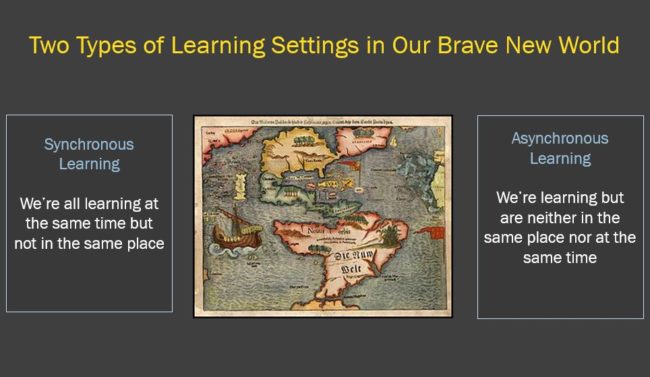03.18.20Mastering Remote Teaching– Intro: Two types of Learning
As you probably know, watching video of teachers in action and sharing bright spots is what my team and I love to do. And while everything has changed in terms of what teachers are being asked to do, we think it’s still helpful to see peers in action and borrow ideas. So starting today we’ll be sharing out video of teachers working online and discussing what we’re learning and what we think works.
Before we start showing you video we want to frame some vocabulary that we find helpful in discussing remote classrooms. Online teaching can take two forms: synchronous and asynchronous.

Synchronous learning is when we’re all learning at the same time but in different places. A zoom session or a good example is a synchronous learning environment–we’re all logged in at the same time and the teachers is talking to us live. Asynchronous learning is when we’re learning neither in the same place nor at the same time. Sending your class a worksheet of problems to email back is an example of asynchronous learning. So is videotaping a lecture that students can watch when they want.
In both cases teachers should be thinking about three kinds of information loops (we’ll be posting more on this later):
- Accountability Loops–You want to gather information on whether students are completing tasks and paying attention to the information you’re sending.
- Formative Loops–The first answer you come up with to a question is rarely sufficient. Students need to compare their answers to those of their peers to see how they’re doing and incorporate new ideas to grow and develop. Discussions and Show Calls and Turn and Talks do that in a typical classroom. We want to try to provide opportunities in an online setting too.
- CFU Loops. CFU, as readers of Teach Like a Champion will know, means Check For Understanding. Teaching needs to change based on the degree to which students have understood what the teacher just taught. This is even more true and even more challenging when you are teaching remotely.
We think good distance learning requires a combination of synchronous and asynchronous settings.
We also think that synchronous settings are harder to do technically and logistically–getting everyone there and logged in at the same time isn’t easy. They often butt up against limits of attention–even adults struggle with online meetings that go much past an hour straight. But synchronous learning is also really important because it allows students and teachers to connect. Seeing your teacher live and feeling a part of something is really important to a lot of students right now. Synchronous learning also lets you respond and assess in real time which is important. Everyone self-studying by watching videos and receiving assignments is going to pose major problems for a lot of learners and we need other tools to know when they’re struggling.
On the other hand asynchronous learning is a lot easier to design and execute so right now that’s a big deal. It allows for lots of practice and more complex assignments. On the other hand it’s a less productive way to disseminate new content… it’s one directional without feedback loops to assess engagement or learning. It’s likely to have asymmetric outcomes.
We think good online learning is going to require some of both. The balances will differ depending on context–age of students, subject matter and perhaps most of all comfort level and proficiency. In other words, right now when everyone is just starting off and trying to figure out online learning as we do it, there’s a decent argument that the most important rule is to keep it simple. You have time to learn to balance three platforms and master the nuances of google classroom. For now more important is building habits for students of getting productive work done in a new world and making them feel connected and part of something. We want to build a foundation. But a little bit of synchronous learning is critical too even if only to build the habits of participation in that venue so you can draw on it more later.

With that in mind I’m going to share another post in about an hour. It shows five or six teachers kicking things off with their students using asynchronous video and I’m going to share some thoughts on how they do it successfully and especially on how they take steps to address its biggest and most pressing weakness–the fact that it’s not great at building community and connection at exactly the time students need that most. So we’ll see how some teachers make kids feel as connected and normal as possible under extreme circumstances.
I can’t wait to share and see what you think! Watch this space for more.

One Response to “Mastering Remote Teaching– Intro: Two types of Learning”